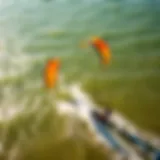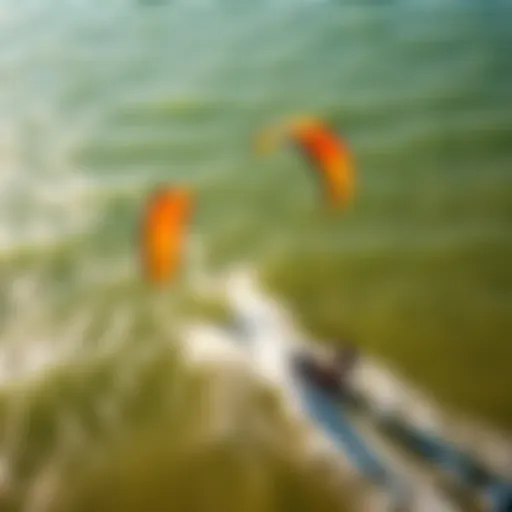Exploring the Crosswing: The Future of Kiteboarding
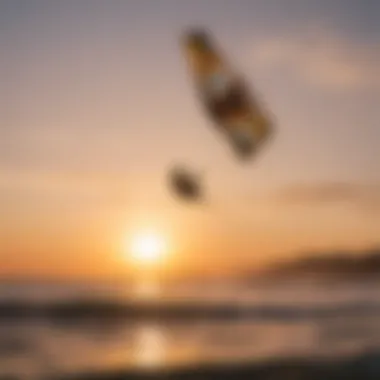

Intro
The realm of kiteboarding has seen its fair share of innovations, but few compare to the rise of crosswing kiteboarding. This emerging trend stands at the intersection of traditional methods and new-age designs, offering enthusiasts an exciting alternative. As the sport evolves, understanding crosswing techniques, gear, and the practical insights associated with this new frontier becomes even more essential.
Crosswing kiteboarding utilizes specialized wings that allow for unique maneuverability and enhanced performance on the water. It's not just another flashy gimmick; it represents a shift in how riders approach the sport, both in terms of their equipment and the skills they hone. In addressing the nuances of crosswing usage, this exploration seeks to illuminate its potential benefits and the vital aspects of the experience.
This piece will delve into gear selection, essential techniques for skill development, safety considerations, and a peek into the future of crosswing kiteboarding. With each segment, we aim to equip riders, instructors, and enthusiasts alike with a well-rounded understanding of this exciting new chapter in kiteboarding and its implications for the sport as a whole.
Prelude to Crosswing Kiteboarding
The emergence of crosswing kiteboarding marks a pivotal shift in the landscape of water sports. Not only does it offer enthusiasts a fresh way to harness the wind’s power, but it also introduces a whole new set of dynamics and possibilities. This introduction serves as a gateway to understanding why crosswing kiteboarding stands out and how it integrates into the broader context of kiteboarding.
Defining the Concept
At its core, crosswing kiteboarding is a hybrid sport that merges principles of kite, windsurfing, and wing foiling. The crosswing, which is a type of wing-shaped sail, provides riders with the ability to glide across water with remarkable agility. Unlike traditional kites, which are tethered and can only be controlled from the ground, crosswings allow for a degree of freedom and maneuverability that captivates both seasoned veterans and newcomers alike.
The uniqueness of the crosswing facilitates a blend of power and control. Riders can catch gusts of wind and, in an instant, pivot around, making it feel like they are dancing on the water. This sensation, coupled with the simplicity of launching and landing the wing, attracts a diverse crowd—from those who enjoy adrenaline-fueled acrobatics to those preferring serene explorations on quiet lakes.
Historical Perspective
Crosswing kiteboarding is not a product of mere chance; it stands on the shoulders of progressive designs and changing riding styles. In the late 20th century, kiteboarding itself took off, embracing ideas that pushed the boundaries of how wind could be utilized. Early iterations of inflatable kites paved the way, enabling riders to achieve higher jumps and smoother rides.
In the recent decade, the evolution of hydrofoiling technology changed the game. Riders began using foils for a sensation of flying just above the water's surface. This made them yearn for equipment that maximized efficiency and performance. The transition to crosswings became a natural progression; manufacturers started experimenting with wing designs that optimized lift while allowing greater control.
Furthermore, the advent of events centered around wingsurfing unveiled the potential crosswing kiteboarding held. As more riders began to take to the water, creating a community around this style, the concept solidified as a key player in the kiteboarding arena. Today’s crosswing kiteboarders benefit greatly from past innovations, while simultaneously pushing the envelope for future developments.
"Crosswing kiteboarding isn't just riding; it's about reimagining the interaction between wind and water."
Through these developments, crosswing kiteboarding not only serves as an exhilarating pastime but becomes a testament to the continual innovation within the kiteboarding community. Thus, understanding its foundation adds depth to the experience and appreciation for those who choose to explore this vibrant new frontier.
The Evolution of Crosswing Design
The evolution of crosswing design is pivotal in grasping the full impact of this cutting-edge sport. Unlike traditional kiteboarding, where development followed a more linear path, crosswing technology highlights innovation through a blend of materials, aerodynamics, and environmental responsiveness. Understanding these elements enhances the riding experience and opens pathways for future advancements. As the popularity of crosswing kiteboarding gains traction, so does the importance of its design and performance characteristics very central to its appeal.
Materials and Technology
One cannot overlook the significance of materials in crosswing design. The advent of lightweight yet durable fabrics has enabled manufacturers to push the envelope, allowing riders to experience stability and responsiveness like never before. For instance, the use of ripstop nylon has become commonplace. This material, initially designed for parachutes, has been adapted for crosswings due to its tear-resistant properties while keeping the overall weight in check.
It’s not just about fabric quality, though. Advances in technology have led to incorporating bladders made from specific thermoplastic polyurethane blends, which maintain buoyancy yet are flexible enough to accommodate various wind conditions. This multi-functional approach ensures that a crosswing can perform capably whether in light breezes or high winds, making it suitable for diverse riding experiences.
Aerodynamics and Performance
Aerodynamics plays a crucial role in how well a crosswing navigates the air. Unlike traditional kites that might rely on fixed structures, crosswings are engineered to maximize lift while minimizing drag. The shape of the wing, often resembling an aircraft wing more than a conventional kite, promotes efficient airflow, allowing riders to harness wind energy more effectively.
Details such as aspect ratio and wing profile have been meticulously designed to enhance stability and control. Riders note that a well-designed crosswing reacts swiftly to input, crafting a seamless connection between the wind and the board. This allows for greater maneuverability and speed, enticing both newcomers and seasoned enthusiasts.
"The crosswing's design isn’t just a product of chance. It’s a result of rigorous testing and feedback from riders to create the ultimate experience on the water."
Comparative Analysis with Traditional Kites
Drawing comparisons between crosswings and traditional kites is a revealing exercise. Traditional kites rely heavily on a single point of pull and often demand more physical strength to control. In contrast, crosswings utilize a two-handed grip akin to windsurfing, distributing forces more evenly. This shift in handling allows for a less strenuous experience, making it appealing to a broader audience.
The versatility of crosswings is evident in their ability to cater to diverse riding styles. Whether a rider seeks the thrill of jumping high or cruising smoothly across the water, the design facilitates both. Moreover, crosswings generally tend to have a quicker setup and takedown process, making them practical for spontaneous excursions.
For a deeper dive into the comparison, consider the following factors:
- Control: Crosswings offer increased control in variable wind conditions.
- User-Friendliness: Easier for novices to get started with less physical demand.
- Mobility: Lightweight construction leads to better portability and storage.
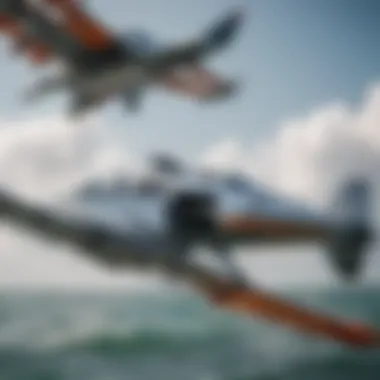

Techniques for Mastering the Crosswing
Understanding the various techniques essential to mastering the crosswing kiteboard is a linchpin for any rider looking to elevate their skills. The interplay between maneuverability, balance, and wind awareness becomes critical as enthusiasts and professionals alike navigate this innovative format of kiteboarding. By honing these techniques, riders can optimize performance and enhance their overall experience on the water.
Basic Maneuvers
Starting with the basics, there are several core maneuvers every aspiring crosswing rider must master to build a solid foundation. These fundamental techniques not only help in developing a keen sense of control but also ensure riders can stay safe while harnessing the wind.
- Takeoff: Begin by positioning the crosswing so that it aligns with the wind's direction. The wing should be raised at a slight angle to catch the breeze, providing enough lift. A proper takeoff sets the tone for your ride.
- Flying the Wing: Once airborne, it's vital to maintain steady pressure on the wing's handles. Riders should practice shifting their center of gravity to steer effectively. Leaning forward or back will change speed and orientation. It’s akin to steering a bike -- intuitive, yet it requires practice.
- Transitioning: Mastering the transition between directions is essential. Riders can practice carving turns by leaning into the turn and managing the wing's position relative to the wind. These turns can be sharp or gentle, allowing the rider to explore how movement affects balance and speed.
Advanced Skills
Once the basics are in hand, the real fun begins with advanced skills. These techniques allow riders to showcase their prowess and push boundaries. Advanced maneuvers not only challenge the rider's control but also make the experience more thrilling.
- Jumping: Jumping with a crosswing requires timing and coordination. Riders should generate speed before pulling up on the wing's handles while pushing down with their feet. The goal here is to create enough lift to momentarily defy gravity. The right wind conditions can make this more thrilling.
- Riding Switch: Riding switch is engaging the board with your non-dominant foot forward. This skill is vital for developing all-around proficiency and adaptability in various conditions.
- Downwind Riding: This technique enables riders to glide smoothly downwind, harnessing wind energy efficiently. Proper wing placement and body positioning become crucial to maintain stability and control while picking up speed.
Common Challenges Faced by Riders
Every sport comes with its challenges, and crosswing kiteboarding is no different. Understanding the potential hurdles that riders may face can help in navigating and overcoming them effectively.
- Wind Variability: Riders often contend with changing wind conditions, which can affect speed and control. Familiarizing oneself with local weather patterns can certainly lend a hand in preparation.
- Balance Issues: Many beginners struggle with balance initially. This can be alleviated through consistent practice and developing core muscle strength which enhances stability.
- Equipment Familiarity: Understanding how to set up and maintain the crosswing gear is crucial. A rider who knows their equipment inside and out can adapt better during rides and troubleshoot issues more effectively.
"The mastery of these skills is not just about performance; it's about the joy and connection one feels with the element of water and wind."
Safety Considerations in Crosswing Kiteboarding
When it comes to any sport that dances with the wind, safety can't be an afterthought. In crosswing kiteboarding, where a dynamic approach meets the thrill of gliding over water, understanding safety measures is critical. Riders need to tread carefully amidst changing conditions—whether it’s gusty winds, shifting tides, or other water traffic. Recognizing potential hazards and preparing for them makes the difference between exhilaration and peril. It’s not just about having a good time; it’s about ensuring that every moment on the water is a safe one.
Recommended Safety Gear
Selecting the right safety gear isn’t simply a checklist task; it’s a matter of trust—trust in your equipment to protect you during your escapades. Here’s a concise guide to essential gear every crosswing kiteboarder should consider:
- Helmet: A good helmet can save your head from unexpected impacts. Opt for one specifically designed for water sports.
- Impact Vest: This provides buoyancy and cushioning, essential for those falls that can happen when you're learning or pushing your limits.
- Leash: A wrist or board leash ensures you don't lose your board during a wipeout, keeping it nearby instead of floating away.
- Life Jacket: Though it might feel cumbersome, a well-fitted life jacket gives added peace of mind.
- Footwear: Shoes or booties protect your feet from sharp objects and enhance grip.
Ensuring each piece of equipment is in good order can keep you on course, literally and figuratively.
Understanding Environmental Risks
Navigating open water with a crosswing demands a keen eye for environmental risks. The conditions can change faster than one realizes, so being mindful is a must. Here are a few pointers to aid in risk management:
- Wind Conditions: Always check wind speeds and directions. Early morning might have calm winds, but it can shift to gusty conditions by noon.
- Water Traffic: Be aware of boats, jet skis, and other watercraft. Many accidents arise when kiteboarders are caught off-guard.
- Tides and Currents: Understanding local tidal patterns can save you from being swept far off course.
- Temperature Extremes: In colder climates, hypothermia can be a risk, even in relatively warm water. A wetsuit might be necessary.
"Assessing environmental factors adds another layer of strategic thinking to your ride. Breathe in the surroundings, and you’ll ride smarter."
Emergency Protocols
Even with precautions, the unexpected can rear its head. Here’s how to be ready:
- Buddy System: Always ride with a partner. You can watch each other’s backs and assist in case of emergencies.
- Communication Devices: Whether it’s a waterproof walkie-talkie or phone, having a way to communicate during emergencies can be invaluable.
- Know Your Exits: Familiarize yourself with the nearest land points or safe areas where you can get help if needed.
- First Aid Kit: Carry a simple first aid kit with essentials such as band-aids, antiseptics, and compression bandages.
- Practice Drills: From rescues to gear failures, practicing emergency scenarios builds confidence and prepares you for real situations.
Staying safe while enjoying crosswing kiteboarding is all about preparedness. Having the right gear, understanding environmental nuances, and knowing how to react in emergencies fosters not just safety but a deeper, more enjoyable experience as you ride the wind.
Crosswing Kiteboarding Destinations
The world of crosswing kiteboarding opens up a canvas filled with exhilarating locations, each presenting unique challenges and rewards. Choosing the right destination to ride your crosswing is not merely a matter of personal preference; it has significant implications for your experience, performance, and safety. The right spot can transform your session from a simple outing into a memorable adventure.
To truly enjoy this thrilling sport, riders must consider elements like wind conditions, water quality, local regulations, and the overall vibe of the location. Knowledge of these factors can make or break a day on the water. Understanding your destination means better preparation, and ultimately, a more enjoyable ride.
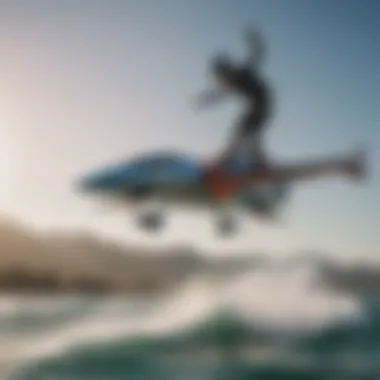

Top Locations for Crosswing Riding
Several destinations around the globe are emerging as ideal spots for crosswing kiteboarding. Each offers its distinct scenery and vibe:
- Kolanta, Thailand: Known for its consistent winds and clear waters, Kolanta attracts many kiteboarders. The beaches are wide and mostly free from crowds, making it perfect for launching and landing your crosswing.
- Cape Town, South Africa: This city is a mecca for board sports enthusiasts. With the iconic Table Mountain as a backdrop, its winds cater perfectly to crosswing riders, particularly at spots like Langebaan and Bloubergstrand.
- Tarifa, Spain: The crossroads of the Mediterranean and the Atlantic, Tarifa boasts strong, reliable winds. Riders there benefit from diverse conditions ranging from choppy waters to flat lagoons.
- Hood River, Oregon, USA: Renowned for its windy conditions and stunning natural beauty, Hood River offers an excellent environment with safety in mind due to local wind patterns. Here, riders often find diverse learning opportunities and a supportive community.
Assessing Conditions and Best Times to Ride
When heading out for crosswing kiteboarding, assessing wind and water conditions is crucial — this isn’t just about having a good time, it’s also about safety. The winds can change faster than you can say "kiteboard!" Here’s what to consider:
- Wind Direction: Understanding how the wind is blowing can significantly affect your riding experience. Always check local forecasts and wind charts. Offshore winds may not be suitable if you’re just starting.
- Wind Speed: Ideal wind speeds vary, but generally, light to moderate winds work best for crosswing kiteboarding. Too gusty or strong winds can lead to challenging conditions, particularly for novices.
- Tides: In certain areas, tidal patterns can impact your ride, altering the water's behavior. When conditions change, it’s essential to pay attention to the tidal cycle.
- Seasonal Variations: Each location has its prime riding seasons. In Tarifa, for instance, the summer months boast the strongest winds, whereas in Cape Town, you might find excellent conditions from November to February.
In summary, choosing the right destination and understanding conditions can elevate your crosswing experience. Engaging with local communities — whether through platforms like Reddit or Facebook — can provide on-the-ground insights that make all the difference.
Always prioritize safety and responsible riding practices, avoiding crowded spots or hazardous areas to ensure your day out remains fun and thrill-packed.
The Role of the Crosswing Community
The crosswing community is not just a collection of enthusiasts; it's a vibrant network of shared experiences, knowledge, and skills. The importance of community in any sport cannot be overstated, and in crosswing kiteboarding, it becomes a vital cornerstone upon which both participation and passion are built. Members support each other through guidance, camaraderie, and a shared love for this exhilarating pursuit, fostering an environment where both novices and seasoned veterans can thrive.
Connecting with Other Riders
One of the biggest advantages of being part of the crosswing community is the opportunity to connect with others who share the same fervor. Online platforms like reddit.com, facebook.com groups, and dedicated kiteboarding forums provide a hub for discussions, sharing tips, and organizing meet-ups. This not only saves time spent on trial and error but often leads to discovering new techniques or equipment that could elevate one’s riding skills.
Moreover, many riders have found lifelong friendships through these connections. Whether it’s those impromptu beach gatherings or organized trips to distant spots, these social interactions enrich the experience beyond just the sport itself. Imagine gliding across the water while your new friends cheer you on from the shore. It brings an added layer of encouragement that is often just as motivating as mastering new tricks on the crosswing.
Instruction and Training Resources
The crosswing community plays a crucial role in providing access to a plethora of instruction and training resources. Local clubs and schools often offer lessons tailored for various skill levels. Instructors are usually themselves passionate about the sport, sharing not only techniques but also safety practices and tips for progressing quickly.
Furthermore, digital resources are aplenty. Websites and platforms dedicated to crosswing kiteboarding provide e-books, video tutorials, and personal blogs filled with firsthand experiences. Many of these resources are often created by enthusiastic riders eager to help others learn. Here are a few recommended places to check:
- YouTube Channels: Specialized channels often feature tutorials ranging from beginner basics to expert tricks.
- Kiteboarding Magazines: Publications frequently cover trends, gear reviews, and instructional content pertaining to crosswings.
- Online Workshops: Participating in virtual workshops can also enhance your understanding of techniques and safety considerations.
Events and Competitions
Making waves in the crosswing world are various events and competitions. These gatherings are not only thrilling to watch but also serve as an excellent way to network with other riders and learn from them. They present an ideal platform to showcase one’s skills and challenge oneself against fellow enthusiasts, pushing the limits of what one can achieve with a crosswing.
Local competitions often have categories for various skill finishes, so there’s space for everyone, from beginners looking to dip their toes into the competitive scene to experienced pilots aiming for the podium. Moreover, events such as the Crosswing Summit and similar gatherings serve as festivals of sorts, celebrating the sport through workshops, performances, and socializing.
"Joining the crosswing community is like opening a door to a broader world of possibilities; every connection can lead to a new adventure."
In summation, the crosswing community is an essential component of the sport, enhancing the experience for everyone involved. From connecting individuals to sharing resources and organizing events, a sense of belonging fosters growth, innovation, and a contagious passion that keeps the spirit of kiteboarding alive and well.
Environmental Impacts of Crosswing Kiteboarding
The rise of crosswing kiteboarding brings with it various ecological considerations, making it crucial to understand the environmental impacts associated with this exhilarating sport. As enthusiasts adopt this innovative approach, it becomes imperative to reflect on how these activities interact with nature, ensuring that the fun does not come at an unnecessary cost to our ecosystems. Crosswing kiteboarding, while often celebrated for its excitement and freedom, also requires mindfulness of the surrounding environment to maintain the delicate balance between enjoyment and sustainability.
Sustainable Practices
Sustainability isn’t merely a buzzword; it represents a commitment to preserving our planet for future generations. In crosswing kiteboarding, practicing sustainability involves a few intentional choices:
- Choosing Eco-Friendly Gear: Many brands are now producing kites and accessories that utilize recyclable materials or processes with a lesser environmental footprint. Opting for gear made from responsibly sourced resources not only promotes a healthier planet but can also enhance performance on the water.
- Responsible Disposal of Equipment: Kiteboarding gear can wear out and become obsolete, thus, being mindful about how to dispose of or recycle such materials is critical. Many communities are embracing local recycling initiatives to allow riders to contribute positively.
- Participating in Clean-Up Initiatives: Many local kiteboarding communities organize beach clean-up events or conservation projects. Participants not only help to protect their sport’s playground but also foster a sense of camaraderie within the community.
By integrating these sustainable practices, kiteboarders can enjoy the thrill of their passion while remaining stewards of the environment.
Conservation Efforts
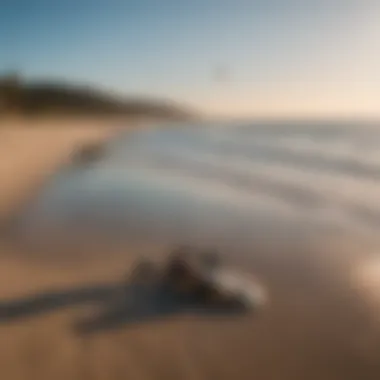

The beauty of coastal environments is intertwined with their biodiversity, making conservation efforts vital for sustaining both flora and fauna. Crosswing kiteboarders can play a role here as well:
- Awareness Campaigns: Many organizations focus on educating riders about local wildlife and habitats. Being aware of nesting areas for birds or sensitive marine ecosystems can influence how and where kiteboarding events should take place.
- Collaborating with Conservation Groups: Establishing partnerships with conservation organizations can help raise funds or awareness for preservation efforts. These alliances can also boost the sport's image as one that values nature and its wellbeing.
“Conservation isn’t just about protecting the environment; it’s about recognizing our role within it.”
- Participating in Local Policy Discussions: Engaging in community dialogues regarding coastal management enables kiteboarders to advocate for sustainable practices that create a lasting impact. Being involved in policy conversations can lead to better management of natural resources, benefiting both the riders and the environment.
In summary, the environmental impacts of crosswing kiteboarding warrant serious consideration, reflecting a growing awareness within the community of their responsibility. Sustainable practices and conservation efforts not only enhance the riding experience but also ensure that the beauty of natural landscapes remains for those who will ride in the future. That balance between thrilling sports and ecological support is not merely beneficial; it is essential.
Future Trends in Crosswing Kiteboarding
The landscape of crosswing kiteboarding is ever-shifting, influenced by technological advances and a burgeoning community of enthusiasts. Understanding the future trends in this sport is not just intriguing but essential for both participants and industry stakeholders. The direction this discipline takes in coming years will likely define the experiences of kiteboarders, offering new approaches to riding on the wind and water.
Innovations on the Horizon
The realm of crosswing kiteboarding is on the brink of several ground-breaking innovations. The technology utilized in kite design has advanced significantly over the past few years, leading not only to enhanced performance but also to safety improvements.
- Materials:
- Inflation Systems:
- Smart Technology:
- Modern kiteboards and wings are increasingly being made from lighter, more durable materials. These innovations allow for better maneuverability and responsiveness. For instance, using ripstop nylon has become a common trend, offering a lightweight structure that withstands the rigors of intense kiteboarding.
- Designers are exploring new inflation and deflation systems that make both setup and takedown quicker and hassle-free, allowing riders to spend more time on the water.
- There's a growing interest in incorporating smart technology into crosswing systems, such as pressure sensors and GPS tracking. This could result in real-time performance feedback for the rider, helping them refine their techniques.
As these innovations develop further, they offer vast potential to enrich the rider's experience and expand the accessibility of the sport.
Potential for Competitive Growth
As crosswing kiteboarding gains momentum, its potential for competitive growth is becoming apparent. This trend is underscored by several factors that could influence participation and organization in the coming years.
- Emerging Competitions: There have been whispers about organizing more structured competitions catering to crosswing kiteboarding. Dedicated events can nurture talent and ignite the competitive spirit among riders, much akin to what we witness in traditional kiteboarding.
- Increased Participation: The appeal of crosswing kiteboarding as a dynamic, engaging sport will likely draw in a wider audience. As awareness grows, more people—ranging from adventurous novices to seasoned pros—will be eager to try their hand at this invigorating activity.
- Sponsorship Opportunities: With increased visibility, sponsorship deals from brands could become more commonplace, promoting both the sport and its riders. Brand partnerships could also lead to better resources for training and competition, thus elevating the overall standard of crosswing kiteboarding.
"Crosswing kiteboarding is set to reshape the competitive scene. Riders are not just participants; they are pioneers crafting the future of this thrilling sport."
As we move forward, engaging with these trends will be crucial for riders, manufacturers, and enthusiasts alike, ensuring that crosswing kiteboarding remains not only relevant but also vibrant.
Finale
The concluding section of an article like this holds great significance. It serves as a synthesis of the insights shared throughout the discussion on crosswing kiteboarding. The essence of this conclusion is to reiterate the key points covered, highlighting the innovations in design, notable techniques, safety measures, and environmental considerations.
This conclusion offers a chance for readers to reflect on the rapid evolution of crosswing kiteboarding. The sport not only introduces a new way of engaging with the wind and water but also emphasizes mindfulness towards our surroundings. Balancing enjoyment with environmental responsibility proves crucial as enthusiasts embrace this thrilling activity.
More than just a sport, crosswing kiteboarding can be viewed as a community, fostering connections among riders and promoting sustainable practices. Those who harness its potential can glean rewards that extend beyond mere athleticism—there’s a whole world of camaraderie, competition, and environmental stewardship at play.
"The journey of learning and mastering crosswing kiteboarding echoes the philosophy of lifelong learning. It’s not just about riding; it’s about evolving alongside the sport itself."
In essence, the conclusion underscores not just the thrill, but also the social and environmental responsibilities that accompany crosswing kiteboarding. As interest in this sport continues to grow, riders and enthusiasts are called to be stewards of both their sport and the environment.
Recap of Key Insights
Summarizing the key takeaways, we can identify several crucial points that encapsulate the journey through this article:
- Innovative Design: The crosswing kite has evolved from traditional models, introducing lighter materials, and enhanced aerodynamics.
- Technique Evolution: Basic to advanced maneuvers provide riders with a range of skills to master, while maintaining a focus on safety.
- Safety Measures: Riders are encouraged to prioritize safety through proper gear and knowledge of environmental risks to ensure enjoyable experiences.
- Community Building: The importance of connecting with other riders cannot be overstated; learning and sharing experiences enhances overall enjoyment and growth in the sport.
- Environmental Consciousness: Active participation in sustainable practices reinforces the role of riders in conserving our beautiful riding locations.
These insights reflect the richness of the sport and the thinking behind its practices.
Encouragement for Continued Exploration
Finally, the call for continued exploration in the realm of crosswing kiteboarding resonates loud and clear. Engaging with this dynamic sport opens doors to further learning, refining techniques, and understanding environmental impacts.
- For those already participating, seeking mentorship or engaging with the community can provide fresh insights. Events and competitions can serve as a platform to hone skills while fostering connections.
- New riders are welcomed into an expansive network, where resources are plentiful. Engaging with various platforms like Facebook groups and Reddit threads dedicated to kiteboarding can enhance learning journeys.
- Furthermore, there always lurks potential for innovation, whether it's new gear, techniques, or sustainability efforts. Keeping an eye on developments will ensure that kiteboarders are at the forefront of this exhilarating sport.
In reflecting upon the evolution and future of crosswing kiteboarding, it stands as a testament to what is possible when passion meets responsibility. So, strap in, continue to explore, and embrace all the waves that lie ahead.










